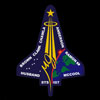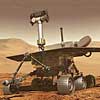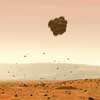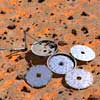|
Sunday:
June 1, 2003 | |
0008 GMT |
 |
Luck may lead to secret of ultimate explosions
A chance observation by a NASA satellite, designed to study the sun, may have uncovered one of the most important clues yet obtained about the mechanism for producing gamma ray bursts, the most powerful explosions in the Universe.
 FULL STORY FULL STORY
 |  |

|
 |
|
Saturday:
May 31, 2003 | |
0133 GMT |
 |
3-D map of local interstellar space shows neighborhood
The first detailed map of space within about 1,000 light years of Earth places the solar system in the middle of a large hole that pierces the plane of the galaxy, perhaps left by an exploding star one or two million years ago.
 FULL STORY FULL STORY
 |  |

|
 |
New method of estimated dwarf novae distances
Astronomers using the Fine Guidance Sensors of the Hubble Space Telescope to study dwarf novae unexpectedly discovered a new method of estimating the distances to these strange double-star systems, using their orbital periods and outburst brightness. In the process they learned that dwarf novae tend to be farther away and much brighter than previously thought.
 FULL STORY FULL STORY
 |  |

|
 |
Japanese science cargo returns to Earth for study
A small Japanese retrievable space capsule landed back on Earth Friday, carrying with it a load of scientific investigations from orbit, Japanese news agencies reported.
 FULL STORY FULL STORY
 |  |

|
 |
|
Friday:
May 30, 2003 | |
0230 GMT |
 |
Foam impact test causes significant T-seal movement
Engineers for the first time Thursday fired a large chunk of foam insulation at a Fiberglass wing leading edge panel, knocking a so-called T-seal out of place and leaving a long gap between two panels. Such a gap on a real shuttle wing leading edge would provide an entry point for deadly super-heated gas during the descent from orbit.
 FULL STORY - updated FULL STORY - updated
 |  |

|
 |
Astronomers 'weigh' planets around pulsar
For the first time, the planets orbiting a pulsar have been "weighed" by measuring precisely variations in the time it takes them to complete an orbit, according to a team of astronomers from the California Institute of Technology and Pennsylvania State University.
 FULL STORY FULL STORY
 |  |

|
 |
Galaxy mission honors lost Columbia crew
NASA's Galaxy Evolution Explorer has gathered its first celestial images, a "first light" milestone dedicated to the crew of the space shuttle Columbia. The ultraviolet survey mission, launched on April 28 from Cape Canaveral, made the observations using its onboard telescope.
 FULL STORY FULL STORY
 |  |

|
 |
|
Thursday:
May 29, 2003 | |
0001 GMT |
 |
Demonstration flight not likely for space shuttle
The chairman of the Columbia Accident Investigation Board said Wednesday he has no plans to require NASA to recertify shuttle systems before flights resume or to mount a test flight of some sort to validate recommended design changes or to collect more data.
 FULL STORY FULL STORY
 |  |

|
 |

Video coverage for subscribers only:
 VIDEO: WATCH WEDNESDAY'S BOARD NEWS CONFERENCE QT VIDEO: WATCH WEDNESDAY'S BOARD NEWS CONFERENCE QT
 SUBSCRIBE NOW SUBSCRIBE NOW

|
Twin roving geologists bound for surface of Mars
Building on past successes -- and learning from embarrassing failures -- NASA is poised to jump start its Mars exploration program by sending a pair of "monster truck" rovers to the Red Planet in an $800 million mission to search for clues about what happened to the water than once carved the martian surface.
 FULL STORY FULL STORY
 |  |

|
 |
Giant airbags will give rovers' landings a bounce
If all goes well, Mars Rover-A will slam into the atmosphere of Mars on January 4, 2004, at an angle of 11.5 degrees, an altitude of about 80 miles and a velocity of 12,000 mph. Eight seconds before touchdown, giant airbags will suddenly inflate, encapsulating the spacecraft in a protective cocoon.
 FULL STORY FULL STORY
 |  |

|
 |
NASA has Mars missions planned through decade
The Mars Exploration Rovers represent the next step in an ambitious, on-going program to explore the Red Planet, to map out its structure, composition and meteorology and to determine whether it ever harbored life.
 FULL STORY FULL STORY
 |  |

|
 |
|
Wednesday:
May 28, 2003 | |
0140 GMT |
 |
Europe shoots for Mars with robotic orbiter and lander
An unprecedented international scientific assault on Earth's cosmic neighbor will be launched in June as four spacecraft are fired to Mars, beginning next week with Europe's first mission to the Red Planet.
 FULL STORY FULL STORY
 ORBITER'S SCIENCE INSTRUMENTS ORBITER'S SCIENCE INSTRUMENTS
 ILLUSTRATION OF MARS EXPRESS' TRAJECTORY ILLUSTRATION OF MARS EXPRESS' TRAJECTORY
 SOYUZ ROCKET FACT SHEET SOYUZ ROCKET FACT SHEET
 |  |

|
 |
The Beagle has landed...
Well, not quite but the innovative Beagle 2 will soon be on its way to Mars aboard European Space Agency's Mars Express. Once at the Red Planet, it may turn up evidence of past or present life.
 FULL STORY FULL STORY
 |  |

|
 |
Mars rover launch delayed
NASA has postponed the launch of its first Mars Exploration Rover at least three days to give managers more time to complete pre-flight engineering reviews. The liftoff is now targeted to occur June 8 aboard a Boeing Delta 2 rocket from Cape Canaveral Air Force Station in Florida.
 FULL STORY FULL STORY
 LAUNCH WINDOWS CHART LAUNCH WINDOWS CHART
 |  |

|
 |
|
Tuesday:
May 27, 2003 | |
0408 GMT |
 |
'Slick Six' launch pad hosts its first Delta 4 rocket
The Boeing Delta 4 rocket and its rebuilt West Coast launch pad came together for their first meeting this month, giving technicians the opportunity to test how everything fits.
 FULL STORY FULL STORY
 |  |

|
 |

Video coverage for subscribers only:
 VIDEO: TAKE A TOUR OF THE SLICK SIX PAD QT VIDEO: TAKE A TOUR OF THE SLICK SIX PAD QT
 VIDEO: VANDENBERG'S FIRST DELTA 4 ROCKET ARRIVES QT VIDEO: VANDENBERG'S FIRST DELTA 4 ROCKET ARRIVES QT
 SUBSCRIBE NOW SUBSCRIBE NOW

|
Deal finally reached to fund Europe's navigation system
Plans to develop the European Galileo satellite navigation network are finally one step closer to reality after the nations contributing to the project reached an agreement Monday on funding.
 FULL STORY FULL STORY
 |  |

|
 |
|
Monday:
May 26, 2003 | |
0210 GMT |
 |
SOHO investigates source of 'fast' solar wind
We have known for 40 years that space weather affects the Earth, which is buffeted by a 'wind' from the Sun, but only now are we learning more about its precise origins. Solving the mystery of the solar wind has been a prime task for ESA's SOHO spacecraft. Its latest findings may overturn previous ideas about the origin of the 'fast' solar wind, which occurs in most of the space around the Sun.
 FULL STORY FULL STORY
 |  |

|
 |
China lofts navigation craft on Long March booster
A Chinese Long March rocket launched the final centerpiece of a satellite navigation system Saturday that aims to provide users with precise positioning information in three dimensions, state-run news reports said.
 FULL STORY FULL STORY
 |  |

|
 |

